Acne Medication Market Research, 2035
The global acne medication market size was valued at $13.4 billion in 2023, and is projected to reach $24.2 billion by 2035, growing at a CAGR of 5.1% from 2024 to 2035. The growth of the acne medication market is driven by surge in prevalence of acne, and surge in research for developing effective treatment. According to a 2023 article by National Library of Medicine, it was reported that acne is a very common chronic inflammatory skin disease that predominantly affects adolescents and young adults. The global prevalence of acne among adolescents is about 80%. Furthermore, the unhealthy lifestyle, poor diet, lack of exercise, and stress have resulted in rise in incidence of acne.
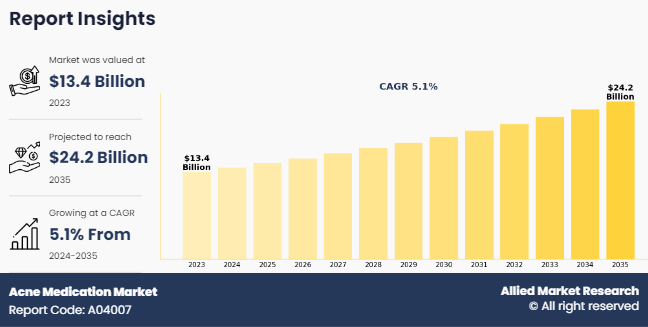
Acne is a common skin condition affecting millions globally. Acne is majorly caused due to excess oil production, clogged pores, bacteria proliferation, and inflammation. Treatment approaches vary, often involving a combination of medications tailored to the severity and type of acne. Retinoids, such as tretinoin and adapalene, are potent topical treatments that unclog pores and promote skin cell turnover. Antibiotics, either oral or topical, combat acne-causing bacteria and reduce inflammation, though concerns about antibiotic resistance persist. Salicylic acid and benzoyl peroxide are commonly prescribed medication for acne.
Key Takeaways
- On the basis of therapeutic class, the retinoid segment dominated the Acne Medication Market in terms of revenue in 2023.
- On the basis of formulation, the topical medication segment dominated the market in terms of revenue in 2023.
- On the basis of type, the prescription medicine segment dominated the market in terms of revenue in 2023.
- On the basis of acne type, the non-inflammatory acne segment dominated the market in terms of revenue in 2023.
- On the basis of distribution channel, the pharmacy and drug store segment dominated the market in terms of revenue in 2023.
- On the basis of region, North America dominated the market in terms of revenue in 2023. However, Asia-Pacific is anticipated to grow at the highest CAGR during the forecast period.
Market Dynamics
The acne medication market size is expected to grow significantly owing to rise in prevalence of acne, unhealthy lifestyle, and rise in the number of teenagers globally. In recent years, there has been a notable rise in the number of individuals, spanning various age groups, who are affected by acne. Several factors contribute to increase in prevalence of acne cases, including changes in lifestyle, dietary habits, hormonal fluctuations, and environmental factors such as pollution and stress. Moreover, increase in awareness and emphasis on skincare routines have led more people to seek treatment for their acne, further propelling the demand for acne medications.
Furthermore, according to acne medication market opportunity analysis rise in awareness and concern for skincare have emerged as significant drivers for the acne medication market, reflecting a societal shift towards prioritizing skin health and appearance. In recent years, there has been a notable increase in individuals actively seeking solutions for their skincare concerns, particularly regarding acne. This heightened awareness can be attributed to various factors, such as the influence of social media, where beauty influencers and celebrities often share skincare routines and product recommendations.
Furthermore, the emphasis on self-care and wellness has encouraged people to invest more time and resources into caring for their skin, leading to a greater demand for effective acne medications. As a result, pharmaceutical companies and skincare brands are responding to this trend by developing innovative products tailored to address acne and other skincare issues. Thus, the growing concerns and awareness about skincare is expected to contribute significantly to the acne medication market growth.
In addition, according to acne medication market forecast analysis rise in the number of teenagers globally has become a significant driver for the acne medication market. Adolescence is a period characterized by hormonal changes, which often trigger the onset of acne. As the global population continues to grow, particularly in regions with high birth rates and improving healthcare access, the number of teenagers entering adolescence is increasing. According to a 2022 article by United Nations Children's Fund, it was reported that there were 1.3 billion adolescents in the world today, more than ever before, making up 16 of the world’s population.
This demographic trend directly correlates with the prevalence of acne, as teenagers are more susceptible to acne than any other age group. Consequently, pharmaceutical companies and skincare brands are capitalizing on this demographic shift by developing and marketing acne medications tailored specifically for teenagers. These products often incorporate formulations designed to address the unique skincare needs of adolescents, such as gentler ingredients to accommodate sensitive teenage skin. Moreover, rise in teenage populations also translates to a greater societal emphasis on skincare education and awareness, as parents, healthcare providers, and educators seek to support teenagers in managing their acne effectively. As a result, the expanding teenage demographic serves as a key driver propelling the growth of the acne medication market size.
Unhealthy lifestyle choices, including poor dietary habits, lack of physical activity, inadequate sleep, and high levels of stress, are expected to contribute to the development and exacerbation of acne. Diets rich in processed foods, sugary snacks, and high-glycemic index foods have been associated with increased risk of acne breakouts due to their potential to spike insulin levels and promote inflammation in the body. In addition, sedentary lifestyles and insufficient physical activity can impair blood circulation and lymphatic drainage, leading to a buildup of toxins and impurities in the skin, which causes acne. Moreover, chronic stress, whether from academic pressures, work-related stressors, or personal challenges, can disrupt hormonal balance and trigger inflammatory responses in the body, further worsening acne symptoms. Thus, acne caused due to unhealthy lifestyle and poor diet is expected to drive the demand for acne medication.
Segments Overview
The acne medication industry is segmented on the basis of therapeutic class, formulation, type, acne type, distribution channel, and region. By therapeutic class, the market is divided into retinoid, antibiotic, salicylic acid, benzoyl peroxide, and others. By formulation, the market is classified into topical and oral medication. By type, the market is distributed into prescription medicine and over-the-counter medicines. By acne type, the market is distributed into non-inflammatory acne and inflammatory acne. By distribution channel, the market is classified into retail stores, pharmacy and drug stores, and e-commerce. Region-wise, the market is analyzed across North America (the U.S., Canada, and Mexico), Europe (Germany, France, the UK, Italy, Spain, and rest of Europe), Asia-Pacific (Japan, China, Australia, India, South Korea, and rest of Asia-Pacific), LAMEA (Brazil, Saudi Arabia, South Africa, and Rest of LAMEA).
By Therapeutic Class
The retinoid segment dominated the global acne medication market share in 2023 and is expected to remain dominant in the forecast period. This is attributed to the fact that retinoids have been extensively studied and proven to be highly effective in treating acne. Retinoids work by promoting cell turnover, preventing the clogging of pores, and reducing inflammation, which are all key factors in acne development. Furthermore, retinoids are versatile in their application. They can be used in various formulations such as creams, gels, and lotions, making them suitable for different skin types and preferences.

By Formulation
The topical medication segment dominated the global acne medication market share in 2023 and is expected to remain dominant in the forecast period. This is attributed to the fact that topical formulations, such as creams, gels, and lotions, are easy to apply directly to the affected skin areas. This convenience appeals to consumers who prefer a simple and straightforward treatment regimen.
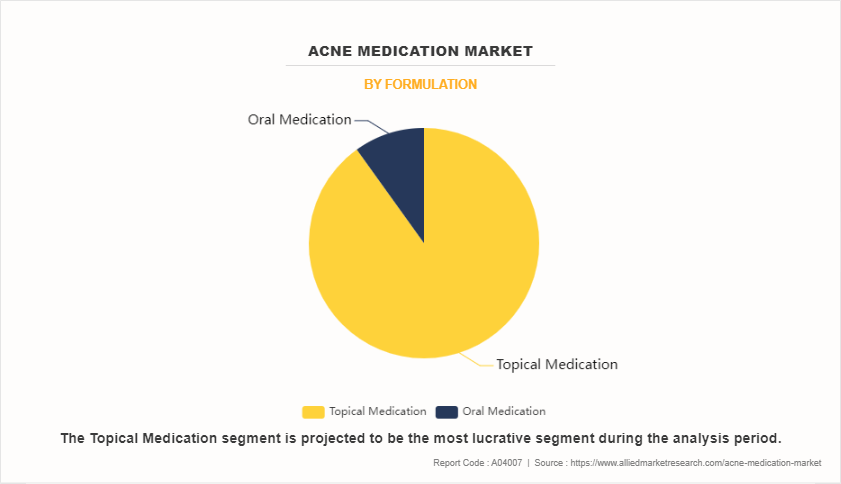
By Type
The prescription medicine segment dominated the global acne medication market share in 2023 and is expected to remain dominant in the forecast period. This is attributed to the fact that prescription medications often contain higher concentrations of active ingredients or utilize more advanced formulations than over-the-counter (OTC) products. This enhanced potency can lead to more effective treatment of acne, especially for moderate to severe cases of acne.
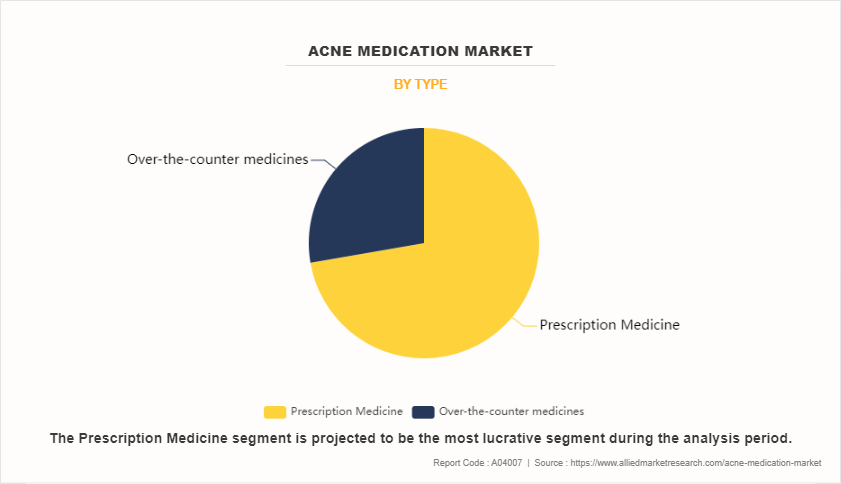
By Acne Type
The non-inflammatory acne segment dominated the global acne medication market share in 2023 and is expected to remain dominant in the forecast period. This is attributed to the fact that non-inflammatory acne is the most common type of acne, affecting a large portion of the population, particularly adolescents and young adults.
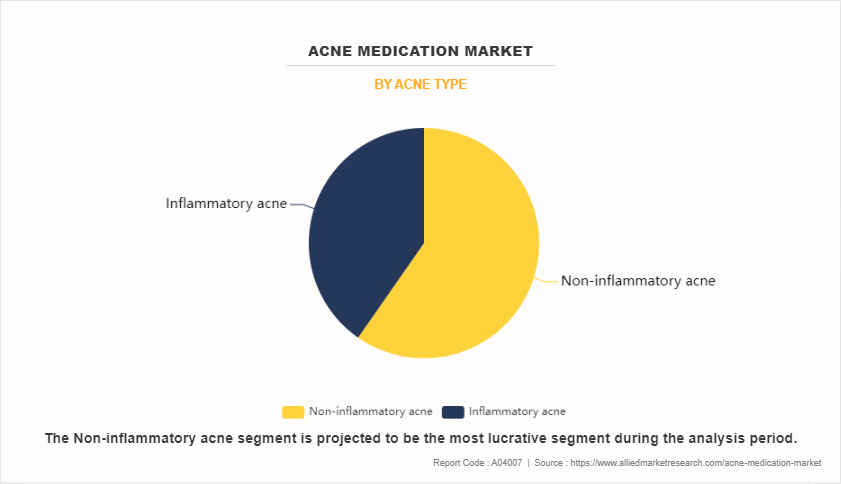
By Distribution Channel
The pharmacy and drug stores segment dominated the global acne medication market share in 2023 and is expected to remain dominant in the forecast period. This is attributed to the fact pharmacies and drug stores are easily accessible to consumers, often located in neighborhoods or easily reachable areas. This accessibility ensures that individuals seeking acne medication can conveniently obtain it without the need for a doctor's prescription in many cases. This ease of access increases the likelihood of purchases, driving revenue for these distribution channels.
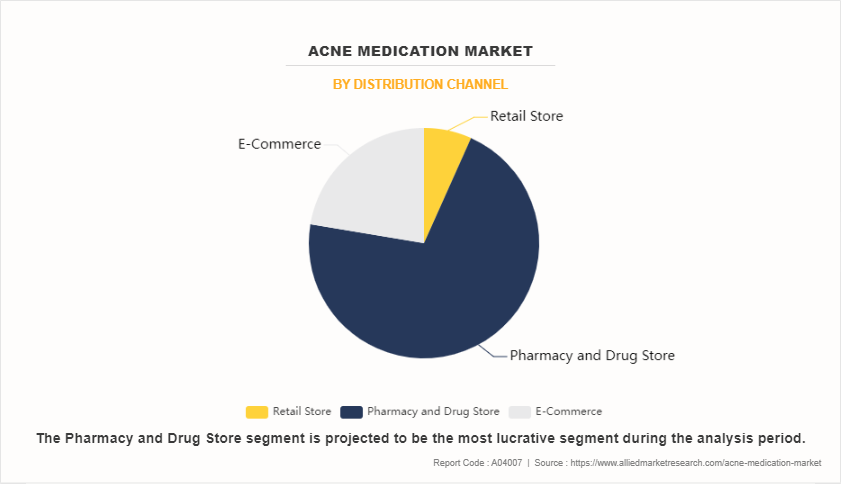
By Region
The acne medication market is analyzed across North America, Europe, Asia-Pacific, Latin America, and Middle East and Africa. North America accounted for a major share of the acne medication market in 2023 and is expected to maintain its dominance during the forecast period. This is attributed to well-developed healthcare infrastructure, strong presence of major key players, and rise in awareness about skincare. However, Asia-Pacific is expected to register the highest CAGR during the forecast period owing to surge in the teenage population and rise in disposable income.
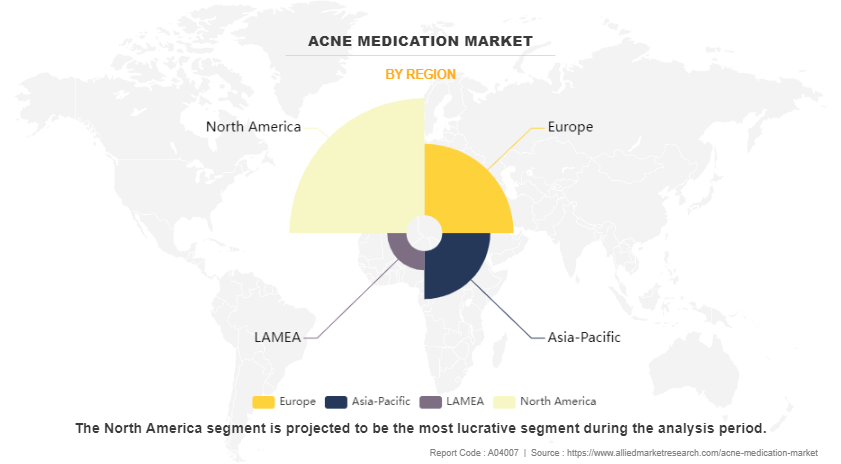
Competitive Analysis
Competitive analysis and profiles of the major players in acne medication industry, such as Bausch Health Companies Inc., Mayne Pharma Group Limited, Sun Pharmaceutical Industries Limited, Johnson and Johnson, GlaxoSmithKline Plc, Mylan N.V., Almirall Sa, Galderma S.A., Teva Pharmaceutical Industries Ltd., and Pfizer Inc. Major players have adopted acquisition as a key developmental strategy to improve the product portfolio of the acne medication market.
Recent Development in the Acne Medication Industry
- In January 2022, Galderma S.A. announced the acquisition of Alastin Skincare, Inc., after receiving an antitrust clearance from federal authorities of the U.S. Rise in consumer interest and increase in popularity of aesthetic skin care procedures had led to increase in demand of the acne treatment products and other skin care products.
Key Benefits for Stakeholders
- This report provides a quantitative analysis of the market segments, current trends, estimations, and dynamics of the acne medication market analysis from 2023 to 2035 to identify the prevailing acne medication market opportunities.
- The market research is offered along with information related to key drivers, restraints, and opportunities.
- Porter's five forces analysis highlights the potency of buyers and suppliers to enable stakeholders make profit-oriented business decisions and strengthen their supplier-buyer network.
- In-depth analysis of the acne medication market segmentation assists to determine the prevailing market opportunities.
- Major countries in each region are mapped according to their revenue contribution to the global market.
- Market player positioning facilitates benchmarking and provides a clear understanding of the present position of the market players.
- The report includes the analysis of the regional as well as global acne medication market trends, key players, market segments, application areas, and market growth strategies.
Acne Medication Market Report Highlights
| Aspects | Details |
| Forecast period | 2023 - 2035 |
| Report Pages | 280 |
| By Type |
|
| By Therapeutic Class |
|
| By Acne Type |
|
| By Formulation |
|
| By Distribution Channel |
|
| By Region |
|
| Key Market Players | Botanix Pharmaceuticals, Pfizer Inc., Bausch Health Companies Inc, Galderma S.A., Kenvue Inc, AbbVie Inc., Teva Pharmaceutical Industries Ltd., Bayer AG, GlaxoSmithKline Plc., Mayne Pharma Group Limited. |
Analyst Review
This section provides various opinions of CXOs in the acne medication market. Over the past few years, the acne market has experienced significant growth, driven by various factors such as rise in awareness about skincare, change in lifestyles, and increase in prevalence of acne among both adolescents and adults. In addition, advancements in technology and formulation have led to the development of more effective and targeted treatments, catering to different types and severities of acne. Pharmaceutical companies have been actively investing in research and development to introduce innovative products with improved efficacy and fewer side effects.
The forecast period for Acne Medication Market is 2024-2035.
The total market value of Acne Medication Market report is $13.4 billion in 2023
The market value of Acne Medication Market in 2035 is expected to be $24.2 billion.
The base year is 2023 in Acne Medication Market.
Major key players that operate in the Acne Medication Market are Bausch Health Companies Inc., Mayne Pharma Group Limited, Sun Pharmaceutical Industries Limited, Johnson and Johnson.
The retinoid segment is the most influencing segment in the Acne Medication Market.
Acne is a common skin condition that occurs when hair follicles become clogged with oil and dead skin cells.
The acne medication market is expected to register significant growth due to rise in incidences of acne and unhealthy diet.
Loading Table Of Content...
Loading Research Methodology...



